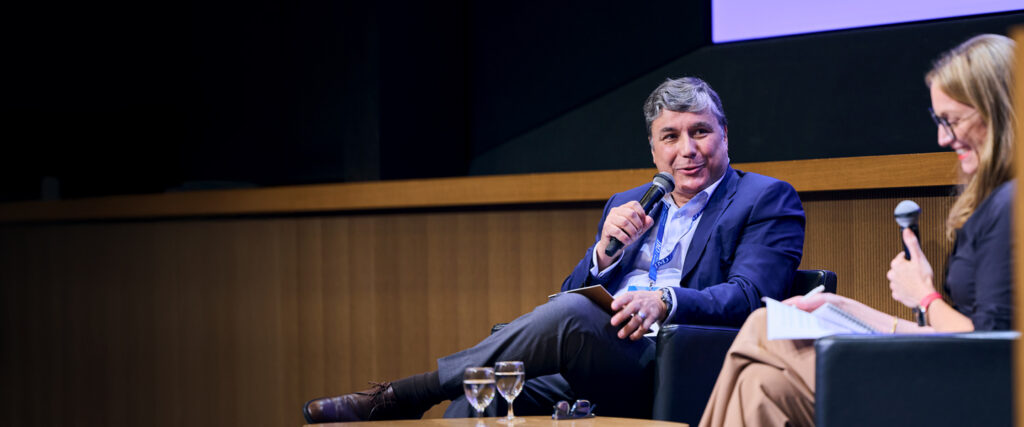Discovery, with purpose: Reshaping R&D for the future
Former Novo Nordisk CSO Marcus Schindler shares insights on pharma R&D, scientific innovation, AI integration and global talent development...
I by IMD is a business intelligence platform designed for today's leaders. We deliver expert-led insights, diverse perspectives, and practical learning tools to help decision-makers navigate critical business challenges.

11 hours ago • by Jennifer Borrer, Saule Serikova in Innovation • 10 min read • 
Aging is now seen as a modifiable biological process. Longevity science is reshaping healthcare, careers, and society for longer, healthier lives....
Continue reading12 hours ago • by Zhike Lei in The Interview • 8 min read
Former Novo Nordisk CSO Marcus Schindler shares insights on pharma R&D, scientific innovation, AI integration and global talent development...
12 hours ago in Brain Circuits • 4 min read
A skills-powered approach to talent management can boost agility, efficiency, and productivity, but transitioning to it is a complex undertaking. Ravin Jesuthasan explains how to get started and identifies the eight pillars...
December 3, 2025 • by Simon J. Evenett, Oliver Jones in Geopolitics • 8 min read
Turbulent times call for clarity of purpose. These five strategic imperatives will help transform how your organization navigates geopolitical volatility and turns uncertainty into competitive advantage....
December 3, 2025 • by Michael R. Wade, Konstantinos Trantopoulos in AI • 4 min read
AI and sustainability are transforming the business landscape, yet many organizations treat the two as separate mandates, led by separate teams pulling in different directions. Instead, they must integrate these forces, using...
December 2, 2025 • by Winter Nie in Leadership • 8 min read
Feedback is essential to growth, but it’s not always easy to give. This second of a three-part series explores why tone and gestures matter just as much as words. ...
December 2, 2025 • by Patrick Reinmoeller in Financial Services (Industry) • 8 min read
Japanese insurance holding company, Tokio Marine Holdings, took a novel, immersive, and “surprising” approach to developing ambidex and aligned future leaders. Here are five talent development lessons they can share with organizations...
 Audio available
Audio availableDecember 2, 2025 • by Amy Bonsall, Alyson Meister in Brain Circuits • 3 min read
At the core of today’s frequent disruptions is ambiguity: situations where the available information is incomplete, contradictory, or constantly shifting, and clear answers are impossible. In the first of a two-part series, Amy Bonsall...
December 1, 2025 • by Stefan Michel in I by IMD Book Club • 4 min read
Gaming has become one of the world’s most powerful consumer ecosystems. Stefan Michel explores why every company now needs a strategy for play to stay competitive. ...
December 1, 2025 • by Julia Binder, Knut Haanaes in I by IMD Podcasts • 2 min read • 
In the second episode of IMD’s sustainability series, IMD's Julia Binder and Knut Haanaes welcome Kunal Chandra of RWE to discuss the energy transition....
December 1, 2025 • by Shelley Zalis in Audio articles • 4 min read
True leadership starts with compassion. Small acts of humanity create lasting impact, shaping cultures rooted in inclusion, awareness, and collective responsibility....
 Audio available
Audio availableDecember 1, 2025 • by Tomoko Yokoi in Artificial Intelligence • 6 min read
Vibe coding lets anyone build apps in plain English using AI, unlocking innovation and speed—but businesses must manage security, compliance, and quality risks....
December 1, 2025 in White Papers • 4 min read
Building resilient energy systems for a fragmented world ...
November 28, 2025 • by Estie Alessandrini in Governance • 6 min read
Use neuroscience and small, measurable actions to build a resilient leadership brain – adaptive, balanced, and primed for peak boardroom performance. ...
November 28, 2025 • by Andrea Wojnicki in Leadership • 8 min read
Identifying your ‘superpowers’ will help you develop a personal brand that will enable you to develop executive presence and flourish as a leader. Here’s how to do it. ...
November 27, 2025 • by Amanda Williams in Audio articles • 5 min read
Companies have buckled under pressure from the Trump administration and challenging economic conditions, but now's not the time to abandon sustainability goals....
 Audio available
Audio availableNovember 27, 2025 • by Didier Bonnet, Achim Plueckebaum in AI • 3 min read
The business case for AI is realized when the application is scaled, not in the use cases of the pilot phase. Use the checklist below at the outset to ensure the transition...
November 26, 2025 • by Milda Mitkute in Innovation • 5 min read
From clearing out her wardrobe to building Lithuania’s first tech unicorn, Vinted founder Milda Mitkute reflects on what it takes to grow responsibly...

Building resilient energy systems for a fragmented world

What the 2025 Future Readiness Indicator
reveals about tech, pharma, and fashion
IMD’s 2025 AI Maturity Index highlights how leaders of the most successful companies are scaling AI technologies across 10 industries for competitive advantage

In the second episode of IMD’s sustainability series, IMD’s Julia Binder and Knut Haanaes welcome Kunal Chandra of RWE to discuss the energy transition.

Walmex CEO Guilherme “Gui” Loureiro on reinventing Walmart Mexico into a purpose-driven digital powerhouse – by overcoming his own ego.

AI has leapt from obscurity to ubiquity, reshaping work and society. But its flaws run deep, forcing leaders to balance its promise with its dangerous limitations.

Former Novo Nordisk CSO Marcus Schindler shares insights on pharma R&D, scientific innovation, AI integration and global talent development

Gaming has become one of the world’s most powerful consumer ecosystems. Stefan Michel explores why every company now needs a strategy for play to stay competitive.

Sustainability can no longer be separated from geopolitics. In this webinar, our experts discuss how rising security risks, disrupted supply chains, and circularity are redefining strategy for global leaders.

Join our monthly webinars to develop your leadership skills and explore trending topics.
Explore first person business intelligence from top minds curated for a global executive audience